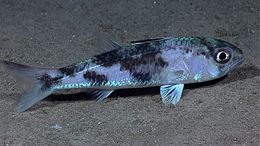| Acropomatidae Temporal range:
| |
|---|---|

| |
| Synagrops bellus | |
| Scientific classification | |
| Domain: | Eukaryota |
| Kingdom: | Animalia |
| Phylum: | Chordata |
| Class: | Actinopterygii |
| Order: | Acropomatiformes |
| Family: | Acropomatidae T. N. Gill, 1893[2] |
| Genera | |
|
See text | |
Acropomatidae is a family of ray-finned fish in the order Acropomatiformes, commonly known as lanternbellies. Acropoma species are notable for having light-emitting organs along their undersides. They are found in all temperate and tropical oceans, usually at depths of several hundred meters.[3] There are about 32 species in as many as 9 genera, although some authorities recognise fewer genera than Fishbase does.
Members of the family are generally small, with some ranging up to 40 cm, but most no more than 15 cm. They have two dorsal fins, the first with seven to 10 spines and the second with possibly a spine in addition to eight to 10 soft rays. The anal fin has two or three spines, and the pelvic fins one spine and five soft rays.
- ^ Sepkoski, J.J.Jr (2002): A Compendium of Fossil Marine Animal Genera. Archived 2011-07-23 at the Wayback Machine Bulletins of American Paleontology, 363: 1-560.
- ^ Richard van der Laan; William N. Eschmeyer & Ronald Fricke (2014). "Family-group names of Recent fishes". Zootaxa. 3882 (2): 001–230.
- ^ Cite error: The named reference
Fishbasewas invoked but never defined (see the help page).